Related Research Articles

Energy storage is the capture of energy produced at one time for use at a later time to reduce imbalances between energy demand and energy production. A device that stores energy is generally called an accumulator or battery. Energy comes in multiple forms including radiation, chemical, gravitational potential, electrical potential, electricity, elevated temperature, latent heat and kinetic. Energy storage involves converting energy from forms that are difficult to store to more conveniently or economically storable forms.
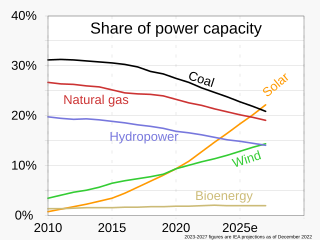
Renewable energy is energy from renewable resources that are naturally replenished on a human timescale. Renewable resources include sunlight, wind, the movement of water, and geothermal heat. Although most renewable energy sources are sustainable, some are not. For example, some biomass sources are considered unsustainable at current rates of exploitation. Renewable energy is often used for electricity generation, heating and cooling. Renewable energy projects are typically large-scale, but they are also suited to rural and remote areas and developing countries, where energy is often crucial in human development. Renewable energy is often deployed together with further electrification, which has several benefits: electricity can move heat or objects efficiently, and is clean at the point of consumption.

Solar energy is radiant light and heat from the Sun that is harnessed using a range of technologies such as solar power to generate electricity, solar thermal energy, and solar architecture. It is an essential source of renewable energy, and its technologies are broadly characterized as either passive solar or active solar depending on how they capture and distribute solar energy or convert it into solar power. Active solar techniques include the use of photovoltaic systems, concentrated solar power, and solar water heating to harness the energy. Passive solar techniques include orienting a building to the Sun, selecting materials with favorable thermal mass or light-dispersing properties, and designing spaces that naturally circulate air.
A Trombe wall is a massive equator-facing wall that is painted a dark color in order to absorb thermal energy from incident sunlight and covered with a glass on the outside with an insulating air-gap between the wall and the glaze. A Trombe wall is a passive solar building design strategy that adopts the concept of indirect-gain, where sunlight first strikes a solar energy collection surface in contact with a thermal mass of air. The sunlight absorbed by the mass is converted to thermal energy (heat) and then transferred into the living space.

Solar thermal energy (STE) is a form of energy and a technology for harnessing solar energy to generate thermal energy for use in industry, and in the residential and commercial sectors.
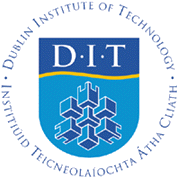
Dublin Institute of Technology was a major third-level institution in Dublin, Ireland. On 1 January 2019 DIT was dissolved and its functions were transferred to the Technological University Dublin, as TU Dublin City Campus. The institution began with the establishment of the first technical education institution in Ireland, in 1887, and progressed through various legal and governance models, culminating in autonomy under a statute of 1992.
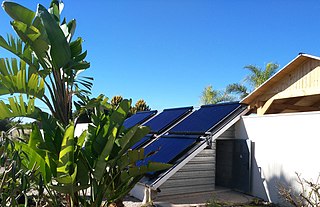
Solar water heating (SWH) is heating water by sunlight, using a solar thermal collector. A variety of configurations are available at varying cost to provide solutions in different climates and latitudes. SWHs are widely used for residential and some industrial applications.

Energy development is the field of activities focused on obtaining sources of energy from natural resources. These activities include the production of renewable, nuclear, and fossil fuel derived sources of energy, and for the recovery and reuse of energy that would otherwise be wasted. Energy conservation and efficiency measures reduce the demand for energy development, and can have benefits to society with improvements to environmental issues.

Thermal energy storage (TES) is achieved with widely different technologies. Depending on the specific technology, it allows excess thermal energy to be stored and used hours, days, months later, at scales ranging from the individual process, building, multiuser-building, district, town, or region. Usage examples are the balancing of energy demand between daytime and nighttime, storing summer heat for winter heating, or winter cold for summer air conditioning. Storage media include water or ice-slush tanks, masses of native earth or bedrock accessed with heat exchangers by means of boreholes, deep aquifers contained between impermeable strata; shallow, lined pits filled with gravel and water and insulated at the top, as well as eutectic solutions and phase-change materials.

Sustainable architecture is architecture that seeks to minimize the negative environmental impact of buildings through improved efficiency and moderation in the use of materials, energy, development space and the ecosystem at large. Sustainable architecture uses a conscious approach to energy and ecological conservation in the design of the built environment.
Renewable heat is an application of renewable energy referring to the generation of heat from renewable sources; for example, feeding radiators with water warmed by focused solar radiation rather than by a fossil fuel boiler. Renewable heat technologies include renewable biofuels, solar heating, geothermal heating, heat pumps and heat exchangers. Insulation is almost always an important factor in how renewable heating is implemented.

Renewable energy commercialization involves the deployment of three generations of renewable energy technologies dating back more than 100 years. First-generation technologies, which are already mature and economically competitive, include biomass, hydroelectricity, geothermal power and heat. Second-generation technologies are market-ready and are being deployed at the present time; they include solar heating, photovoltaics, wind power, solar thermal power stations, and modern forms of bioenergy. Third-generation technologies require continued R&D efforts in order to make large contributions on a global scale and include advanced biomass gasification, hot-dry-rock geothermal power, and ocean energy. As of 2012, renewable energy accounts for about half of new nameplate electrical capacity installed and costs are continuing to fall.

Concentrated solar power systems generate solar power by using mirrors or lenses to concentrate a large area of sunlight into a receiver. Electricity is generated when the concentrated light is converted to heat, which drives a heat engine connected to an electrical power generator or powers a thermochemical reaction.

100% renewable energy means getting all energy from renewable resources. The endeavor to use 100% renewable energy for electricity, heating, cooling and transport is motivated by climate change, pollution and other environmental issues, as well as economic and energy security concerns. Shifting the total global primary energy supply to renewable sources requires a transition of the energy system, since most of today's energy is derived from non-renewable fossil fuels.
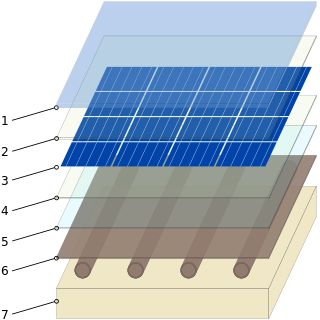
Photovoltaic thermal collectors, typically abbreviated as PVT collectors and also known as hybrid solar collectors, photovoltaic thermal solar collectors, PV/T collectors or solar cogeneration systems, are power generation technologies that convert solar radiation into usable thermal and electrical energy. PVT collectors combine photovoltaic solar cells, which convert sunlight into electricity, with a solar thermal collector, which transfers the otherwise unused waste heat from the PV module to a heat transfer fluid. By combining electricity and heat generation within the same component, these technologies can reach a higher overall efficiency than solar photovoltaic (PV) or solar thermal (T) alone.
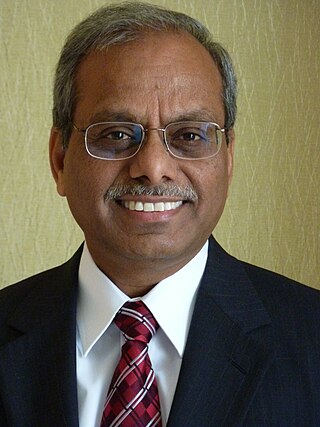
Rakesh Agrawal is a chemical engineer known for contributions to separations, cryogenic gas separation and liquefaction, and for contributions to renewable energy including the conversion of biomass to chemicals and fuels, inorganic solar cell fabrication, and the synergistic use of solar energy. He is the Winthrop E. Stone Distinguished Professor of Chemical Engineering at Purdue University.
Mahendra Singh Sodha, popularly known as M. S. Sodha, is an Indian physicist specialising in Plasma, Optics and Energy and a former vice chancellor of Lucknow University, Devi Ahilya University and Barkatullah University. A 1974 winner of the highest Indian science award, Shanti Swarup Bhatnagar Prize, Sodha was honoured by the Government of India again in 2003 with Padma Shri, the fourth highest Indian civilian award.

The Dublin Institute of Technology (DIT) School of Electrical and Electronic Engineering (SEEE) is the largest and one of the longest established Schools of Electrical and Electronic Engineering in Ireland. It is located at the DIT Kevin Street Campus in Dublin City, as part of the College of Engineering & Built Environment (CEBE).

Technological University Dublin or TU Dublin is Ireland's first technological university, established on 1 January 2019, and with a history stretching back to 1887 through the amalgamated Dublin Institute of Technology which progressed from the first technical education institution in Ireland, the City of Dublin Technical Schools. It is the second-largest third-level institution in Ireland, with a student population of 28,500.

The European Academies' Science Advisory Council (EASAC) is a regional association of National Academies of science. Its members are 25 National Science Academies of the Member States of the European Union (EU), and the National Science Academies of Norway, Switzerland and the UK. Malta and Luxembourg do not have National Academies of Science. A pan-European Academy (Academia Europaea) and a network of all Academies from across the continent of Europe also have membership (ALLEA). EASAC was founded in June 2001 and was headquartered at the German National Academy of Sciences Leopoldina in Halle (Saale) until 31 December 2022.
References
- ↑ "New President is appointed for DIT". Irish Independent. 27 April 2003.
- ↑ "Prof Brian Norton reappointed as DIT President". The Irish Times. 17 April 2013.
- ↑ "ITs or Tech Unis". The Irish Times. 16 February 2014.
- ↑ "The transforming landscape of higher education in Ireland". Public Affairs Ireland. 4 April 2014.
- ↑ "Finishing touches as DIT campus opens in the heart of city". The Irish Times. 4 September 2014.
- ↑ "DIT opens new campus in Grangegorman to first students". Irish Independent. 10 September 2014.
- ↑ "Pádraig Hoare: Time for a green light for the sustainable energy of the future". 24 August 2020.
- ↑ "Special Report: Endless possibilities of solar power investment". 9 November 2020.
- ↑ "Incentives needed for heat pumps to take off". 24 November 2020.
- ↑ "DIT President elected to membership of the Royal Irish Academy". Astronomy Today. 1 June 2016.
- ↑ "Admittance Day 2016 | Royal Irish Academy". Archived from the original on 5 October 2016. Retrieved 4 October 2016.
- ↑ "EuroCase website".[ permanent dead link ]
- ↑ "deux sommites de la science a troyes naomi j halas et brian norton seront presents a lutt du samedi 25 au mercredi 29 septembre 2021". utt.fr. Archived from the original on 23 September 2021. Retrieved 6 October 2021.
- ↑ "Brian Norton".
- ↑ (PDF) https://easac.eu/fileadmin/PDF_s/reports_statements/Decarb_of_Buildings/EASAC_Decarbonisation_of_Buildings_Web_publication030621.pdf.
{{cite web}}: Missing or empty|title=(help) - ↑ Norton, Brian (2013). Harnessing Solar Heat. Springer. ISBN 978-94-007-7275-5.
- ↑ Norton, Brian (1992). Solar Energy Thermal Technology. Springer. ISBN 978-1-4471-1744-5.
- ↑ Sayigh A (Editor) (2012). Comprehensive Renewable Energy. Elsevier. ISBN 978-0-08-087872-0.
{{cite book}}:|last=has generic name (help) - ↑ Enteria N and Akbarzadeh A (Eds) (2013). Solar Energy Sciences and Engineering Applications. CRC Press. ISBN 978-1138000131.
- ↑ E Michalena (Editor) (2013). Renewable Energy Governance. Springer. ISBN 978-1-4471-5595-9.
{{cite book}}:|last=has generic name (help) - ↑ E. Coyle and R.A. Simmons, eds (2014). Understanding the Global Energy Crisis. Purdue University Press. ISBN 978-1-55753-661-7.
{{cite book}}:|last=has generic name (help) - ↑ G Crawley, ed (2016). Solar Energy. World Scientific Press. ISBN 978-981-4689-49-6.
{{cite book}}:|last=has generic name (help)